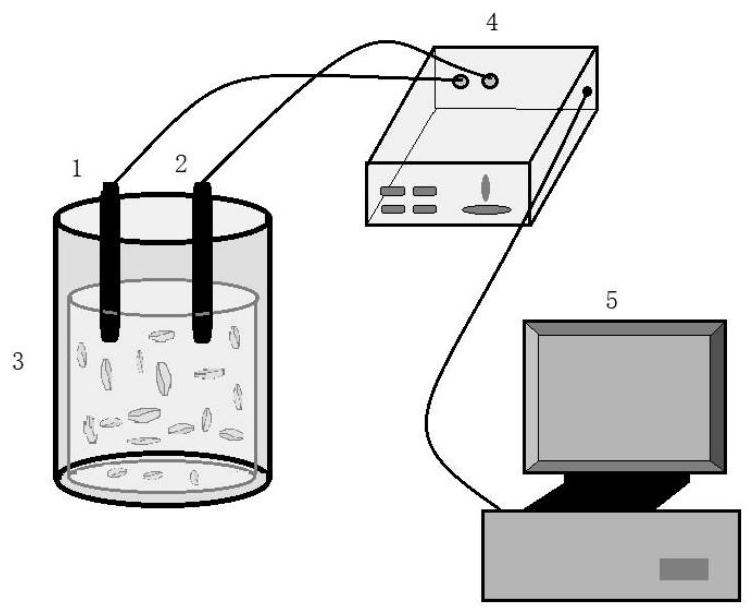Microbial fuel cell for monitoring number of microorganisms and monitoring system and method
A microbial count and fuel cell technology, applied in biochemical fuel cells, fuel cells, battery electrodes, etc., can solve problems such as the inability to monitor the microbial count, and achieve faster monitoring speed and accuracy, low cost, and improved stability. effect of life
- Summary
- Abstract
- Description
- Claims
- Application Information
AI Technical Summary
Problems solved by technology
Method used
Image
Examples
Embodiment 1
[0031] A microbial fuel cell for treating nitrate and capable of monitoring the number of microorganisms. The microbial fuel cell is composed of a cell body, an anode, and a cathode. The cell body is provided with a cathode and an anode, and a neutral nitrate solution and an active Sludge and activated sludge are taken from the anaerobic tank of the domestic sewage treatment plant. The basic parameters of the sludge are as described in Table 1, and the volume ratio of activated sludge to solution is 1:1.
[0032] Table 1 The basic parameters of the sludge used
[0033] parameter value TCOD (total chemical oxygen demand) (mg / L) 13000 SCOD (soluble chemical oxygen demand) (mg / L) 600 TSS (total suspended solids) (g / L) 20 VSS (Volatile Suspended Solids) (g / L) 15
[0034] Both the cathode and the anode float on the buffer solution, and the solution used for the reaction is composed of a concentration of 0.01 mol L - 1 NaNO 3 made, and adde...
Embodiment 2
[0047] In the pool body of the microbial fuel cell, add an inoculant equivalent to 2% of the total mass of rice husk and sludge, mix it evenly and heat it with a heating mantle at 50°C for 4 hours to ensure the full activation of the inoculum, and then use the blood cell counting method to Count the number of microorganisms under the microscope, then connect the microbial fuel cell and each unit and module, start the microbial fuel cell, and collect the current value and compare it with the standard curve after the operation is stable. The measurement results show that the number of microorganisms is 1.332×10 6 , so the measurement deviation is 4.0%.
Embodiment 3
[0049] In the pool body of the microbial fuel cell, add an inoculant equivalent to 2% of the total mass of rice husk and sludge, mix it evenly and heat it in a heating mantle at 60°C for 4 hours to ensure the full activation of the inoculum, and then use the blood cell counting method to Count the number of microorganisms under the microscope, then connect the microbial fuel cell and each unit and module, start the microbial fuel cell, and collect the current value and compare it with the standard curve after the operation is stable. The measurement results show that the number of microorganisms is 1.098×10 6 , so the measurement deviation is 3.0%.
[0050] According to the above-mentioned embodiments, the monitoring system of the present application can quickly detect the number of microorganisms in the microbial fuel cell, and the measurement deviation is small, which can effectively solve the problem of when to add microorganisms and the number of microorganisms in practica...
PUM
 Login to View More
Login to View More Abstract
Description
Claims
Application Information
 Login to View More
Login to View More - R&D
- Intellectual Property
- Life Sciences
- Materials
- Tech Scout
- Unparalleled Data Quality
- Higher Quality Content
- 60% Fewer Hallucinations
Browse by: Latest US Patents, China's latest patents, Technical Efficacy Thesaurus, Application Domain, Technology Topic, Popular Technical Reports.
© 2025 PatSnap. All rights reserved.Legal|Privacy policy|Modern Slavery Act Transparency Statement|Sitemap|About US| Contact US: help@patsnap.com

